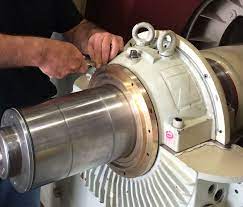A sleeve bearing, also known as a plain bearing, is a type of bearing that is used to reduce friction and support rotating or sliding shafts within machinery. It consists of a cylindrical metal sleeve or bushing that provides a smooth and low-friction surface for the shaft to rotate or slide against. Sleeve bearings are commonly used in various mechanical systems to provide support and reduce wear between moving parts.

Key features of sleeve bearings include:
- Construction: Sleeve bearings are typically made of materials like bronze, brass, steel, or other self-lubricating materials. The inner surface of the bearing may be coated with a lubricating material or impregnated with lubricant to reduce friction.
- Installation: Sleeve bearings are designed to be press-fit or otherwise securely mounted into the housing or casing of the machinery. The shaft then fits snugly inside the bearing, allowing it to rotate or slide smoothly.
- Lubrication: Many sleeve bearings rely on the lubrication properties of the materials used or require external lubrication to reduce friction and prevent wear. However, some modern sleeve bearings are designed to be self-lubricating, utilizing materials that release lubricant as the bearing rotates.
- Types: There are different variations of sleeve bearings, including:
- Journal Bearings: These are the most common type of sleeve bearings and are used to support rotating shafts.
- Thrust Bearings: These are designed to handle axial loads (forces applied along the shaft’s axis) and are used to prevent axial movement of the shaft.
- Advantages:
- Simplicity: Sleeve bearings have a straightforward design, making them easy to manufacture and install.
- Cost-Effective: They are often less expensive to produce compared to more complex bearing designs.
- Low Maintenance: Some self-lubricating sleeve bearings require minimal maintenance, as they can continuously release lubricant as needed.
- Limitations:
- Friction and Heat: Sleeve bearings may generate more friction and heat compared to other types of bearings, potentially leading to increased wear and reduced efficiency.
- Limited Load Capacity: They may have lower load-carrying capabilities compared to roller or ball bearings, making them more suitable for lighter loads.
- Wear: Over time, sleeve bearings may wear down and require replacement or maintenance.
Sleeve bearings are commonly found in various applications, including electric motors, fans, pumps, and other rotating machinery. Their simplicity and cost-effectiveness make them suitable for situations where moderate precision and load-bearing capabilities are required. However, the choice of bearing type depends on the specific requirements of the machinery and the intended use case.